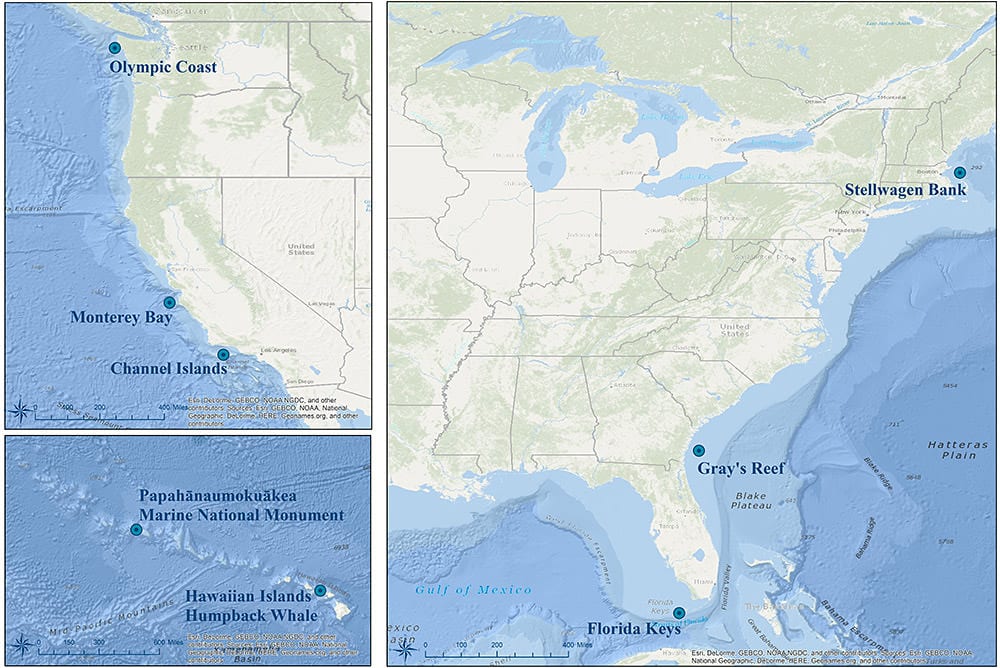Listening to fish with passive acoustics
WHOI and NOAA Fisheries researchers adapt marine mammal detection technologies for fisheries management
By Elise Hugus | October 1, 2020

Over the past decade, scientists at the Woods Hole Oceanographic Institution and NOAA Fisheries have established the effectiveness of passive acoustic devices to detect marine mammals. More recently, the researchers have broadened their scope to include fisheries management applications. Using acoustic telemetry tags on fish, hydrophones on the ocean floor, and passive acoustic detection devices mounted on gliders and moorings, it's now possible to listen to anything in the ocean that makes a sound—natural or man-made—and monitor changes.
“We’re putting all our resources together, exploring how the technology can help answer different questions about fisheries management and protected species,” says Sofie Van Parijs, the head of the passive acoustics research group at NOAA’s Northeast Fisheries Science Center in Woods Hole.
Whales and dolphins are known for their otherworldly vocalizations, but some fish also use sound to communicate. In a series of collaborative studies, WHOI and NOAA scientists are leveraging these acoustic signals to find out whether commercially valuable Atlantic cod and haddock are impacted by sound from shipping and offshore wind farm construction.
This past winter, with funding from the Bureau of Ocean Energy Management (BOEM), WHOI biologist Mark Baumgartner and Van Parijs sent a glider to Cox Ledge, the southernmost spawning ground for Atlantic cod, and the site of a proposed wind farm. In addition to male cod, the glider detected numerous whales, as well as sharks, seals, and fish tagged with telemetry devices. Once analyzed, the data will help fisheries managers better understand cod spawning behavior, and whether offshore wind construction or fishing activity is appropriate in certain areas and times of year.

As part of an ongoing collaboration with Van Parijs and scientists at NOAA’s Stellwagen Bank National Marine Sanctuary, biologists and WHOI collaborators Jenni Stanley and Paul Caiger are investigating cod spawning dynamics and the responses of cod and haddock to noise from ships passing through the sanctuary. In a 2017 study, published in Nature Scientific Reports, they found that the noise from constant ship traffic reduced the effective range of communication for both species. Using passive acoustic recorders to detect vocal activity, another recent study identified a new cod spawning location in the sanctuary—and demonstrated the effectiveness of using the technology to manage this commercially and ecologically important species.
Stanley is the East Coast lead coordinator on a project with NOAA and the US Navy called SanctSound, which involves using hydrophones and telemetry devices to capture the soundscape at four national marine sanctuaries from the Northeast to the Florida Keys. The goal is to record three years of continuous sound from these marine protected areas, which Stanley hopes will reveal how each ecosystem is changing over time.
“We really want to be able to use the information contained in the soundscape to evaluate the biodiversity and changes due to human construction, climate change, or even COVID-19,” Stanley says. “It’s going to be really telling to see how things have changed due to the coronavirus in places like Stellwagen and the Florida Keys, which see a lot of tourism and recreational boating.”
A longfin squid reacts to recorded sound of pile-driving in an experimental tank at Aran Mooney's lab. (Video courtesy of Ian Jones © Woods Hole Oceanographic Institution)
Passive acoustics are not the only way to study changes in animal behavior in response to noise. In a BOEM-funded study on the effects of offshore construction on longfin squid and black sea bass, Stanley and WHOI biologist Aran Mooney played a recording of pile-driving from the Block Island Wind Farm to animals in tanks using an underwater speaker.
For the sea bass experiment, Stanley joined forces with the NOAA Fisheries lab in Sandy Hook, New Jersey, which boasts a 32,000-gallon tank. After acclimating the test subjects for nearly a year, Stanley and Fisheries biologist Beth Phalen found that a lot of the sea bass sank to the bottom and froze there, greatly reducing activities important to feeding, communication and breeding behaviors for the duration of the sound. At WHOI, Mooney found that the noise induced a strong startling effect in squid, which dissipated as the sound continued, and was less strong if the squid was eating or trying to mate. Future studies aim to investigate the animals’ response to pile-driving in a field setting.
“We are still learning how sound propagates in the ocean, particularly in specific places like close to the bottom and essential fish habitats” says Mooney. “By putting our heads together with colleagues at NOAA, we leverage resources, analysis, and expertise so we can focus on our specialties. We can get two studies done for the price of one.”
